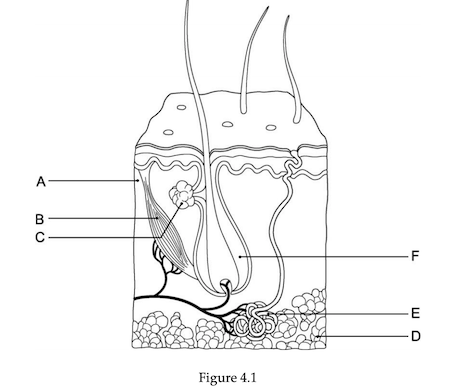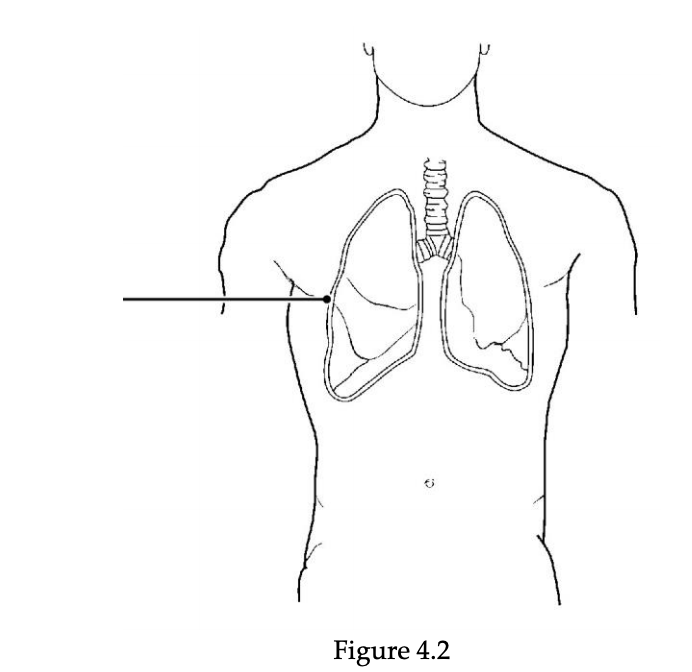
The region that contains adipose tissue is indicated by letter __________.
D

The hair follicle is indicated by letter __________.
F

The structure that is responsible for whorled ridges on the epidermal surfaces is indicated by letter __________.
A

The structure that pulls the hair follicle into an upright position is indicated by letter __________.
B

The gland that produces a mixture of oily substances and fragmented cells is indicated by label __________.
C

The gland that produces sweat is indicated by label __________.
E
Which moist epithelial membrane lines body cavities that open to the
exterior:
A) cutaneous
B) synovial
C)
peritoneum
D) serous
E) mucous
E
The categories of epithelial tissue membranes are: A) synovial, cutaneous, and mucous membranes
B) synovial, cutaneous, and serous membranes
C) synovial, mucous, and serous membranes
D) synovial, mucous, and cutaneous membranes
E) mucous, cutaneous, and serous membranes
E
Which type of membrane contains fluid between the visceral and perietal layers:
A) synovial
B) serous
C) cutaneous
D) mucous
E) connective
B
Which of the following relationships is incorrect:
A) visceral peritoneum - covers the outer surface of the small intestine
B) parietal pericardium - covers the outer surface of the heart
C) parietal pleura - lines the wall of thoracic cavity D) visceral pleura - lines the surface of the lungs
E) parietal peritoneum - lines the wall of the abdominal cavity
B
Which of the following is a connective tissue membrane:
A) synovial membrane
B) cutaneous membrane C) mucous membrane
D) serous membrane
E) pleural membrane
A
Synovial membranes are found in the:
A) joint cavities
B) covering of the heart
C) lining of the stomach cavity
D) covering of the brain
E) lining of the abdominal cavity wall
A
Sweat glands associated with hair are:
A) sebaceous glands
B) sudoriferous glands
C) eccrine glands
D) sebaceous glands and eccrine glands
E) sudoriferous glands and eccrine glands
B
Which of the following is a vital function of the skin: A) it converts modified epidermal cholesterol to vitamin D
B) it aids in the transport of materials throughout the body
C) the cells of the epidermis store glucose as glycogen for energy
D) it absorbs vitamin C so that the skin will not be subject to diseases
E) it aids in desiccation
A
Although you get wet while swimming, a tough protein within the skin prevents it from soaking up moisture like a sponge. This substance is:
A) serous fluid
B) melanin
C) mucus
D) carotene
E) keratin
E
The epidermis is composed of:
A) simple columnar epithelium
B) stratified squamous epithelium
C) adipose tissue
D) areolar tissue
E) dense fibrous connective tissue
B
The uppermost layer of skin is:
A) called the dermis
B) full of keratin
C) fed by a good supply of blood vessels
D) called the hypodermis
E) composed of dense connective tissue
B
The hypodermis consists of:
A) simple columnar epithelium
B) stratified squamous epithelium
C) adipose tissue
D) loose connective tissue
E) dense fibrous connective tissue
C
A needle would pierce the epidermal layers of the forearm in which order:
1. stratum basale
2. stratum corneum
3. stratum granulosum
4. stratum lucidum
5. stratum spinosum
A) 2, 3, 5, 1
B) 1, 5, 3, 4, 2
C) 2, 4, 3, 5, 1
D) 1, 3, 5, 2, 4
E) 2, 3, 4, 1, 5
A
Which of the following homoeostatic imbalances is caused by skin exposure to chemicals:
A) athlete's foot
B) cold sores
C) impetigo
D) contact dermatitis
E) cyanosis
D
The "tanning" effect (darkening of the skin) that occurs when a person is exposed to the sun is due to:
A) melanin
B) keratin
C) oil
D) Langerhans cells
E) sweat
A
The layer of the epidermis in which cells first die because of their inability to get nutrients and oxygen is the:
A) stratum spinosum
B) stratum granulosum
C) stratum basale
D) stratum corneum
E) stratum lucidum
E
Melanocytes are found in the:
A) stratum spinosum
B) stratum lucidum
C) stratum corneum
D) stratum basale
E) stratum granulosum
D
A splinter penetrates to the deepest layer of the epidermis on your foot. This layer is:
A) stratum basale
B) stratum corneum
C) stratum granulosum
D) stratum lucidum
E) stratum spinosum
A
Epidermal cells that are actively mitotic and replace superficial cells that are continually rubbed off are: A) stratum granulosum cells
B) stratum corneum cells
C) stratum lucidum cells
D) stratum spinosum cells
E) stratum germinativum cells
E
Nutrients reach the surface of the skin (epidermis) through the process of:
A) absorption
B) evaporation
C) filtration
D) diffusion
E) osmosis
D
Which of the following is NOT a true statement about the papillary layer of the dermis:
A) it is the deepest layer of the skin
B) it produces the pattern for fingerprints
C) it contains nerve endings that respond to touch and temperature stimuli
D) it is highly vascular
E) it is located immediately beneath the epidermis
A
In order to warm the body up when cold:
A) vitamin D is synthesized
B) sudoriferous glands release sweat
C) sebaceous glands release oil
D) the arrector pili muscles contract to stand hairs upright
E) melanin is produced
D
Finger-like upward projections of the dermis into the epidermis are called:
A) hair follicles
B) hair bulbs
C) Meissner's corpuscles
D) dermal papillae
E) Pacinian corpuscles
D
Nails are composed of:
A) melanin
B) hemoglobin
C) keratin
D) sebum
E) carotene
C
The secretions of the eccrine glands are:
A) primarily uric acid
B) mostly water, sodium chloride, and trace amounts of wastes, lactic acid, and Vitamin C
C) fatty substances, proteins, antibodies, and trace amounts of minerals and vitamins
D) solely metabolic wastes
E) basic
B
The secretion of sweat is stimulated:
A) by high temperatures
B) when the air temperature drops
C) by hormones, especially male sex hormones
D) as a protective coating when one is swimming
E) both by high temperatures and by hormones, especially male hormones
E
Sudoriferous glands are important for:
A) production of keratin
B) keeping skin and hair cells soft and flexible
C) production of sweat
D) body heat regulation
E) production of vitamin D
D
Inflammation of the hair follicles and sebaceous glands is called:
A) impetigo
B) alopecia
C) psoriasis
D) boils
E) contact dermatitis
D
What is the first threat to life from a massive third-degree burn:
A) infection
B) dehydration
C) unbearable pain
D) loss of immune function
E) blood loss
B
What is the first threat to life from a massive third-degree burn:
A) infection
B) dehydration
C) unbearable pain
D) loss of immune function
E) blood loss
B
A physician estimates the volume of fluid lost in a severely burned patient by:
A) measuring urinary output and fluid intake
B) observing the tissues that are usually moist
C) blood analysis
D) using the "rule of nines"
E) performing enzyme studies
D
Which of the following is an indication of melanoma: A) a symmetrical mole
B) a pigmented spot that has smooth borders
C) a spot on the skin that is smaller than the size of a pencil eraser
D) a pigmented spot that is black
E) a pigmented spot that contains areas of different colors
E
Acne and seborrhea are caused by problems with: A) eccrine glands
B) nail beds
C) sudoriferous glands
D) sebaceous glands
E) hair follicles
D
Male pattern baldness has a genetic switch that turns on in response to:
A) age
B) size
C) weight
D) male hormones
E) female hormones
A

The membrane shown in Figure 4.2 is:
A) cutaneous membrane
B) synovial membrane
C) pericardium, a serous membrane
D) mucous membrane
E) pleura, a serous membrane
E
T/F: Membranes that line body cavities that have openings to the exterior of the body are called mucous membranes.
TRUE
T/F: The serous membrane that covers the external surface of both lungs is called the visceral pleura.
TRUE
T/F: When an individual is exposed to extremely low air temperatures, the capillaries of the skin will dilate so that blood will flush into skin capillary beds and heat will be dissipated.
FALSE
T/F: The outermost layer of the epidermis is the stratum basale.
FALSE
T/F: The pinkish hue of healthy individuals with fair skin is the result of the crimson color of oxygenated hemoglobin circulating in the dermal capillaries and reflecting through the dermis.
TRUE
T/F: The major portion of the skin is comprised of the dermis.
TRUE
T/F: The epidermis is made up of stratified squamous epithelium.
TRUE
T/F: Skin is also known as a synovial membrane.
FALSE
T/F: A serous membrane is composed of a layer of simple squamous epithelium resting on a thin layer of areolar connective tissue.
TRUE
T/F: Eccrine and apocrine glands are the two types of sebaceous glands.
FALSE
T/F: Melanin is found in the uppermost layer of skin and helps prevent water loss.
FALSE
T/F: Hair is produced by the hair bulb and is composed primarily of dead keratinized cells.
TRUE
T/F: The thickened, proximal area of the nail is called the nail matrix, and it is responsible for nail growth.
TRUE
T/F: The reason that the nail bed appears pink is the presence of a large number of melanocytes in the underlying dermis.
FALSE
T/F: Joe just burned his hand on a hot pot. A blister forms and the burn is painful; Joe's burn would best be described as a third-degree burn.
FALSE
T/F: The nail is actually a modification of the skin and corresponds to the hooves of animals.
TRUE
T/F: The downy type of hair covering a newborn is called vernix caseosa.
FALSE
T/F: The ABCD rule is used for classifying burns.
FALSE
T/F: In first-degree burns, only the epidermis is damaged.
TRUE
T/F: Squamous cell carcinoma arises from cells of the stratum spinosum.
TRUE
Type of membrane that is dry
A) serous membrane
B) mucous membrane
C) cutaneous membrane
D) synovial membrane
C
Type of membrane adapted for absorption or secretion
A) serous membrane
B) mucous membrane
C) cutaneous membrane
D) synovial membrane
B
Type of membrane that has no epithelial cells at all
A) serous membrane
B) mucous membrane
C) cutaneous membrane
D) synovial membrane
D
Type of membrane that contains a visceral and a partietal layer
A) serous membrane
B) mucous membrane
C) cutaneous membrane
D) synovial membrane
A
Only example of a connective tissue membrane
A) serous membrane
B) mucous membrane
C) cutaneous membrane
D) synovial membrane
D
Type of membrane that lines open body cavities
A) serous membrane
B) mucous membrane
C) cutaneous membrane
D) synovial membrane
B
Peritoneum, pericardium, and pleura are examples of this type of membrane
A) serous membrane
B) mucous membrane
C) cutaneous membrane
D) synovial membrane
A
The skin and its derivatives (nails, glands, and hairs) form
the:
A) integumentary system
B) immune system
C)
skeletal system
D) endocrine system
E) lymphatic system
A